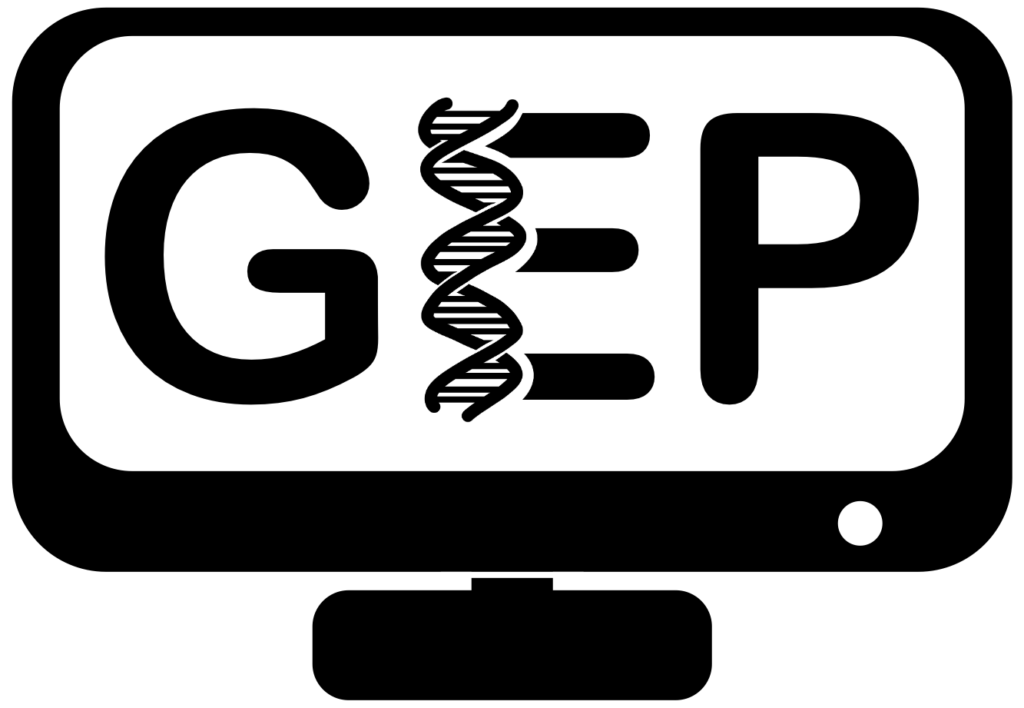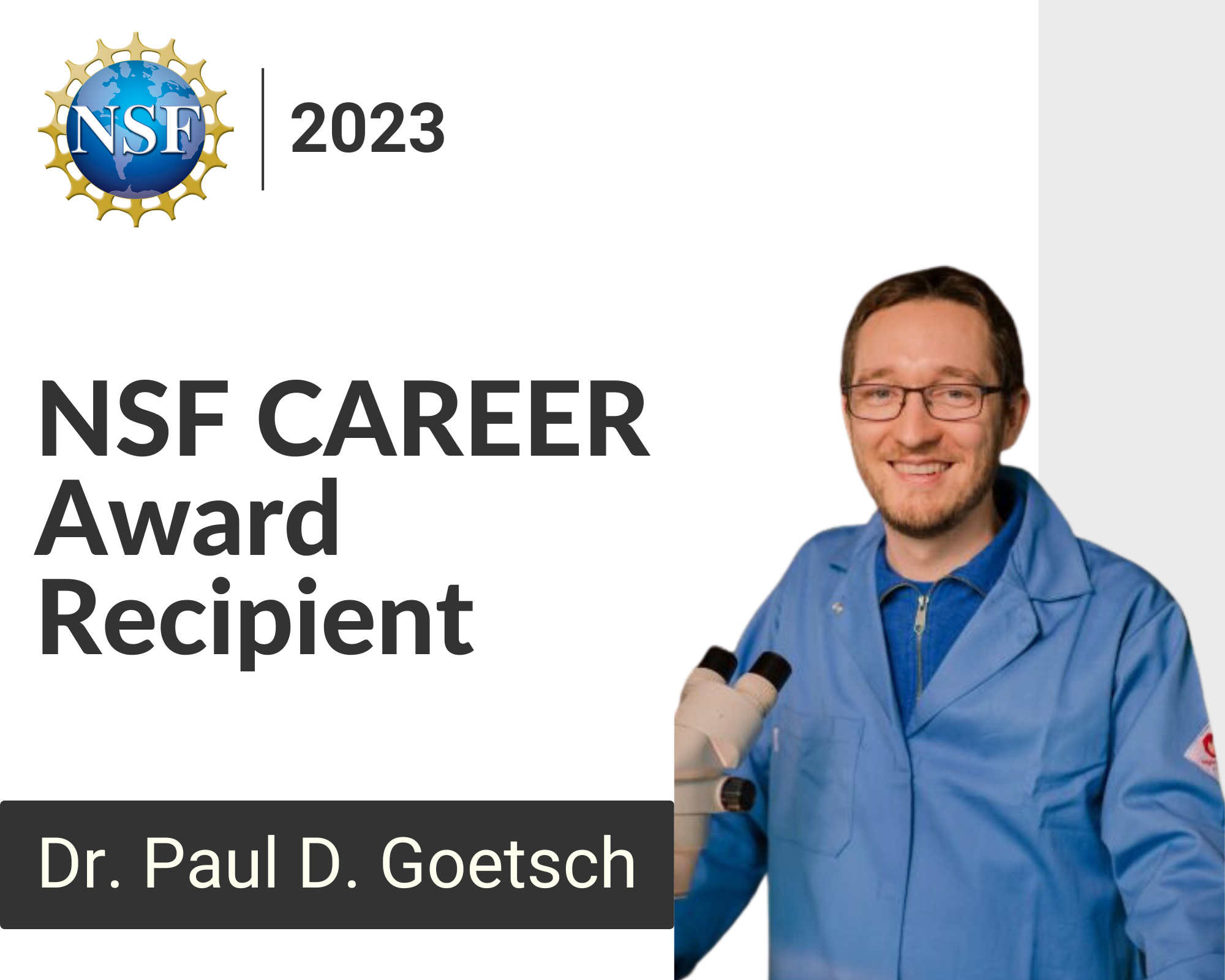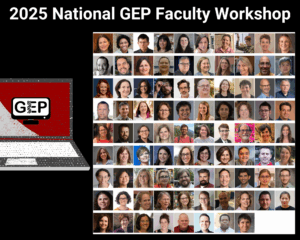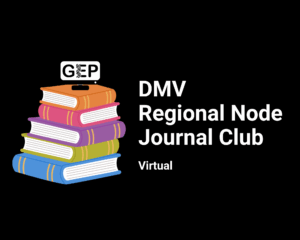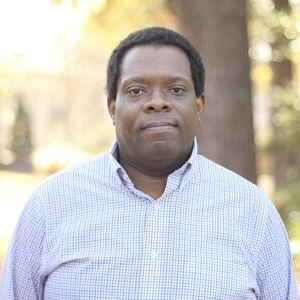"Dr. Goetsch is Michigan Tech’s third NSF CAREER Award recipient this year and this year’s first from the College of Science and Arts, joining Drs. Hassan Masoud and Radwin Askari from the College of Engineering. The award focuses on the integration of his teaching and research efforts and further exemplifies the dedication and commitment of our faculty."
David Reed, vice president for research at Michigan Tech
NSF CAREER Awards are one of the most prestigious acknowledgements of early-career faculty, recognizing and supporting their abilities to serve as role models in research and education.
In this Michigan Tech News Q&A, Goetsch explains the benefits of pulling the two components together to contribute to important discoveries in the field and excite a new generation of researchers.
Q: What is your project about and what do you hope to accomplish?
PG: The NSF CAREER Award offers a unique challenge to combine my research program with my teaching ambitions in the biological sciences program. My research centers on understanding what defines cell identity. I’m fascinated by how multiple cell types are generated from the same genome. But instead of studying what makes a liver cell a liver cell, I more broadly study the difference between somatic cells — cells that make up the body — compared to germ cells, which are cells that are part of the reproductive system. Most of my research uses the Caenorhabditis elegans model system. C. elegans is a microscopic roundworm well suited to introduce students to genetic research. In C. elegans, deactivation of a particular class of regulatory proteins causes a breakdown of somatic cell identity, causing proteins that should only be made in germ cells to be made also in somatic cells. I’m interested in understanding what drives this breakdown, and I’m excited that part of this research will include the work of students who enroll in BL2210 Genetics Lab. Not only are we going to get into the weeds about genetics and cellular identity, but the students will gain hands-on experience with technologies like CRISPR-Cas9 genome editing and RNA interference, and even learn the tools researchers use to “browse” genomes and understand the structure of eukaryotic genes.
Why is understanding cellular identity important? What are the implications?
PG: I’m a basic science researcher, so what keeps me going back to the lab is just wanting to understand how the cells in our bodies work when everything is going right. Unfortunately, what works correctly can also go sideways in any biological system. In humans, breakdown of cell identity is most commonly associated with cancer. In fact, the breakdown of somatic cell identity I study in C. elegans is also observed in cancer cells. Therefore, our work in a model system holds promise for understanding what molecular pathways get activated as normal cells become cancerous.
"It’s my long-term goal to use this knowledge to develop new anti-cancer therapeutics or a novel diagnostic method aimed to detect early cancer development."
Paul Goetsch, NSF CAREER Award recipient
How does your project wed genomics and bioinformatics?
PG: Another exciting component of this project is that it incorporates some curriculum from the Genomics Education Partnership (GEP), a national group of researchers from 200-plus institutions aiming to better prepare life science students in fields of bioinformatics and genomics. We’re still riding the “genomic revolution” that launched from completion of the Human Genome Project in 2003. Twenty years later, genomics and the methods to deal with the massive amounts of biological information, called bioinformatics, touch upon all aspects of life science work. By joining with the GEP, I’m aiming to learn how to better prepare Michigan Tech students for whatever career path they choose. So, in BL2210 Genetics Lab and a new course I’m developing on advanced eukaryotic genomics (starting in fall 2024), Tech students will have the opportunity to get hands-on experience in browsing genomic information and learn the structure and complexity of eukaryotic genes. All the research I do culminates in gaining a genomic perspective of the changes that result from breakdown of cell identity, and this project aims to offer students a look “under the hood” as my research team tackles our complex research questions.
Tell us about CUREs and how it will prepare students for careers in the life sciences.
PG: CUREs stands for course-based undergraduate research experiences. My intent for implementing CUREs in BL2210 Genetics Lab is to introduce MTU students to what life science research is like by guiding student groups in an open-ended project that tackles a research question with experiments that don’t have known results. We have piloted a few CUREs since 2021 — I’m excited to share the results of our work soon. Overall, the CUREs are designed to provide every biological sciences student with a glimpse into the opaque world of scientific research. My intent is to use the course experience to advertise current research opportunities on campus for those interested in pursuing undergraduate research further. But even if students don’t elect to pursue research as a career, gaining understanding that discoveries are made by tackling one research question at a time is a valuable experience.
How did you get involved in this field of research? What drew you to it?
PG: My story in science really began with undergraduate research and that is why I value the opportunity to design CUREs in the courses I teach at MTU. What started the ball rolling was my willingness to just try research in any form. I started my journey in a physical chemistry lab at the University of Washington (UW) in Seattle. The work was well over my head, but gave me the confidence to leap over to biochemistry to study protein structure and cancer biology in Dr. Rachel Klevit’s lab at UW. Obviously something stuck, as I pursued a Ph.D. in biochemistry at the University of Wisconsin-Madison, where I got a crash course in genomics research. Then, as a postdoctoral researcher in Dr. Susan Strome’s lab at the University of California in Santa Cruz, I added genetics and genomic engineering techniques to my repertoire.
Ultimately, what drew me in were the research questions. From “How does this protein work?” to “What happens when this protein binds DNA?” to “What happens when I mutate this part of this protein?” Each question pulled me further into wanting to understand the relationships between genomes, genes and proteins, and how their interplay controls cellular identity.
Is there a person or group at Tech who helped to make this research and award possible?
PG: Yes, of course! The Department of Biological Sciences has always been supportive of my work. I will give a specific shoutout to an early collaboration with Dr. Thomas Werner at the beginning of my tenure here at MTU, which directly led to my joining the Genomics Education Partnership. Additionally, I am collaborating with Dr. Stephen Techtmann to improve the bioinformatic curriculum in the department in support of our computational biology degree program. Finally, no research program is formed in a vacuum, so advice from Dr. Caryn Heldt and members of the Health Research Institute was instrumental in honing my pitch to the National Science Foundation.
What does this award mean to you and how does it help advance your research goals?
PG: Recognition from my peers and the National Science Foundation is energizing. This award will give me the opportunity and freedom to develop a more impactful research program, and I’m especially excited to tackle the challenge of further integrating my research into the classroom.
Anything else you’d like to share?
PG: My work with students in CUREs led me to join both GEP and another national group that offers resources for research in undergraduate education: the Bridging Research and Education With Model Organisms (BREWMOR) steering committee. These are ways that my team at Tech can share with the research community what the students discover and the value they gained from the experience. I’m aiming to use this project to build new crowdfunding and possibly crowdsourcing-type projects, all centered on genetics and genomics CUREs offered at Michigan Tech. So stay tuned!
